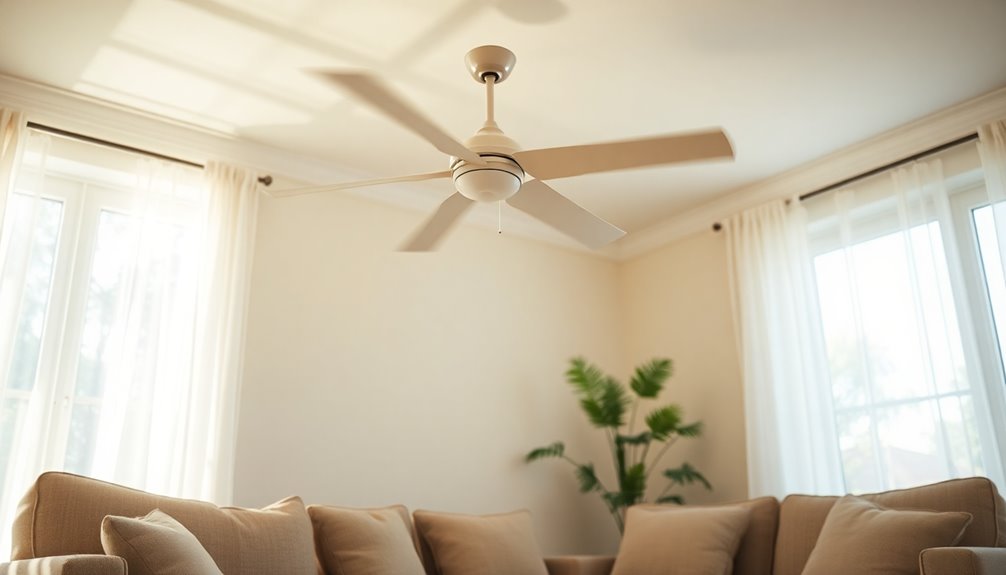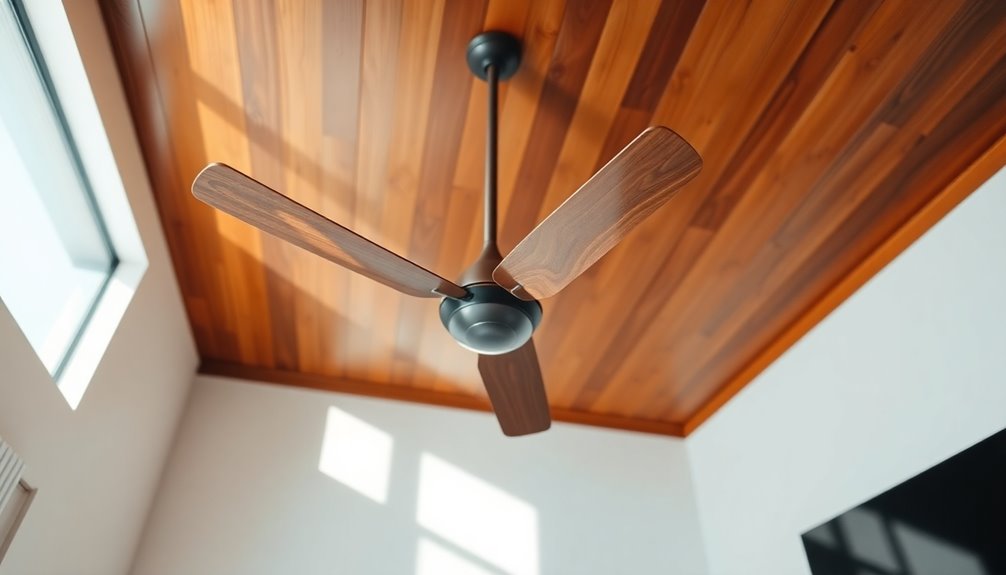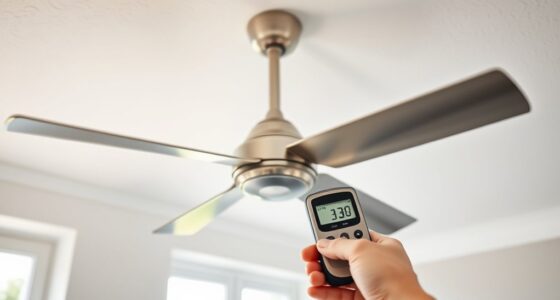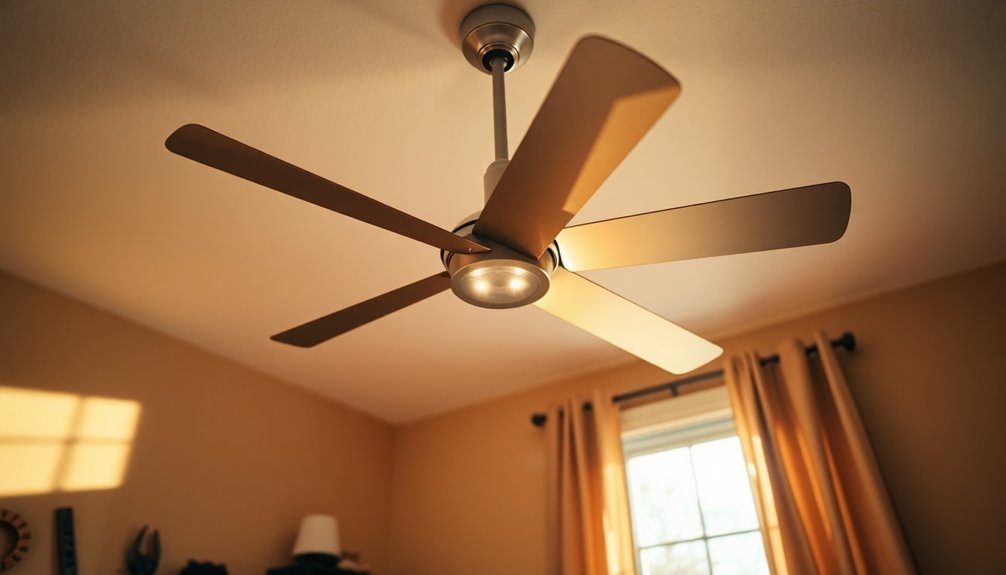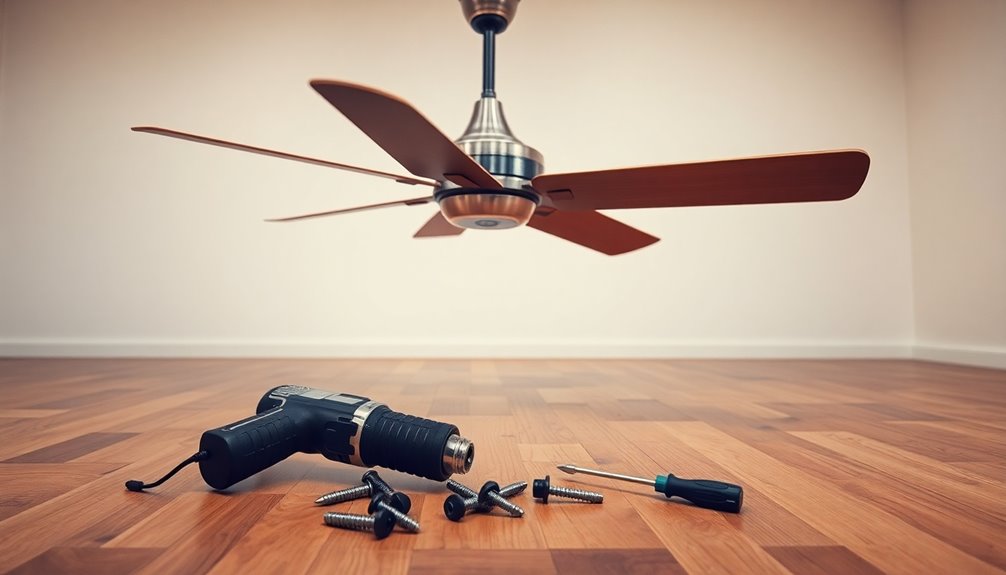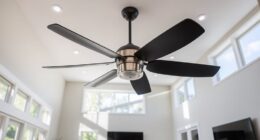In summer, you should set your ceiling fan to spin counterclockwise. This direction creates a cooling downdraft, enhancing the wind chill effect and making your space feel cooler. By running your fan at medium to high speed, you can even raise your thermostat setting by about 4 degrees without losing comfort, saving you on energy costs. It's essential to check that the fan's direction is correct, so stand beneath it to confirm. For even more effective cooling tips and ways to maximize your ceiling fan's performance, keep exploring the details.
Key Takeaways
- Set ceiling fans to spin counterclockwise in summer to create a cooling downdraft for enhanced comfort.
- Use medium to high speed for optimal cooling and to maximize the wind chill effect.
- Adjust the fan direction in spring for summer and switch it to clockwise in fall for warm air circulation.
- Ensure the fan is off before changing direction and confirm counterclockwise spin by standing beneath the fan.
- Regularly maintain fan blades for better airflow and efficiency, ensuring they are clean and at optimal angles.
Importance of Ceiling Fan Direction

When it comes to staying comfortable at home during the hot summer months, the direction of your ceiling fan plays an important role. To achieve peak comfort and efficiency, you should set your ceiling fan to spin counterclockwise. This summer mode creates a downdraft that pushes cool air downwards, enhancing the cooling effect throughout your space.
Proper ceiling fan direction is vital, as it can greatly impact your energy bills. When your fan runs in the correct direction, you can raise your thermostat setting by about 4 degrees, still feeling comfortable while enjoying potential energy savings of up to 30%.
The airflow generated by a counterclockwise fan helps maintain a consistent room temperature, reducing the need for constant air conditioning operation.
Additionally, adjusting your ceiling fan direction seasonally not only improves air circulation but also maximizes the efficiency of your heating and cooling systems.
This simple adjustment guarantees peak comfort year-round, allowing you to enjoy your home without breaking the bank on energy costs.
Benefits of Using Ceiling Fans

Using ceiling fans offers numerous benefits that go beyond just keeping your space comfortable in summer. When you set your ceiling fans direction to rotate counterclockwise, they create a wind chill effect that pushes cool air downward. This enhances your comfort without actually lowering the air temperature, allowing you to feel cooler even on hot days.
Moreover, utilizing ceiling fans can enable you to increase your thermostat by about 4 degrees Fahrenheit, which can lead to energy savings of up to 30%. By improving air circulation, ceiling fans reduce the need for constant air conditioning operation, greatly lowering your cooling costs.
If you pair your ceiling fans with ENERGY STAR-rated air conditioning units, you can enjoy an additional 8% energy savings.
Regular maintenance and correct operation of ceiling fans not only help you keep cool but also guarantee peak performance and longevity. This contributes to overall energy efficiency in your home.
Ceiling Fan Settings for Summer

To maximize comfort during the summer, you should set your ceiling fan to spin counterclockwise. This direction creates a downdraft that pushes cooler air downwards, markedly enhancing your comfort level. The fast counterclockwise rotation helps create a wind chill effect, making you feel cooler without needing to lower the thermostat.
Running the fan at high speed can allow you to increase your thermostat setting by up to 4 degrees while still feeling comfortable. Not only does this improve your comfort, but it can also reduce energy costs by up to 30%, as you won't rely on air conditioning as much.
To verify your ceiling fan is set correctly, stand beneath it and feel for a strong breeze, indicating the proper counterclockwise motion. Here's a quick reference table for ceiling fan settings:
| Setting | Effect |
|---|---|
| Spin Counterclockwise | Creates cooler air |
| High Speed | Enhances wind chill |
| Reduced AC Use | Lowers energy costs |
| Strong Breeze | Confirms proper direction |
How to Change Fan Direction

Adjusting your ceiling fan's direction is a straightforward process that can greatly enhance your summer comfort.
To change your ceiling fan for the summer months, begin by confirming the fan is turned off for safety. If your fan has a pull chain, locate the direction switch on the fan body and slide it to the opposite direction. Once that's done, turn the fan back on.
For remote-controlled fans, you'll need to turn off the fan first. Then, press and hold the fan button on the remote until the light blinks, indicating the direction has changed.
If you have a smart fan, simply use the SIMPLEconnect app or a voice command to toggle the fan direction after confirming it's off.
Finally, always check the direction by standing under the fan to confirm it's spinning counterclockwise. This direction creates a cooling downdraft effect, keeping your space comfortable during hot summer days.
Optimal Blade Angles for Cooling

To maximize your cooling experience, you'll want to set your ceiling fan blades at an angle of at least 12 degrees.
This angle helps push air down effectively, enhancing airflow and efficiency in your space.
Just remember, angles above 16 degrees can create turbulence, so finding the right balance is key for comfort.
Recommended Blade Angles
For ideal cooling, ceiling fan blades should be set at a minimum angle of 12 degrees. This angle helps create effective air circulation, ensuring you feel that invigorating breeze during the summer months. When the blade angles are at least 12 degrees, you maximize the cooling efficiency of your ceiling fan.
However, you should be cautious not to exceed 16 degrees; higher angles may disturb airflow, negatively impacting your comfort.
In larger rooms over 500 square feet, you might need multiple fans to achieve optimal cooling. Adjusting the blade angle can greatly enhance air circulation, which not only improves comfort but can also contribute to lower energy costs. Additionally, selecting a ceiling fan with energy-efficient motors can further enhance performance and reduce electricity bills.
Regularly checking and maintaining the blade angles is essential for keeping your ceiling fan operating at peak performance.
Airflow and Efficiency
How can the right blade angle enhance your ceiling fan's cooling efficiency?
Adjusting your ceiling fan blades can noticeably improve airflow and maximize the cooling effect in your space. For summer use, make sure the blade angle is set between 12 and 16 degrees. This ideal position allows the fan to effectively push cool air downward without creating excessive airflow that might disturb loose objects.
Here are three key points to keep in mind:
- Blade Angle: Maintain a minimum angle of 12 degrees to guarantee effective air circulation.
- Ceiling Fan Switch: Regularly check the fan direction in summer, making sure it's set to counterclockwise for ideal airflow.
- Room Size: In larger rooms over 500 square feet, consider using multiple ceiling fans to maintain an efficient cooling effect and improve overall air circulation.
Ceiling Fans With Air Conditioning

Using ceiling fans alongside your air conditioning can markedly enhance your home's cooling efficiency.
When you operate a ceiling fan, it can make a noticeable difference in how cool your space feels. By circulating the cool breeze generated by your air conditioning, you can regulate air flow more effectively, allowing you to feel comfortable even with the thermostat set a few degrees higher. This is especially beneficial when combined with energy-efficient appliances, which can help to lower overall energy consumption. In fact, many modern HEPA filter vacuums can also contribute to better air quality, making the cooling process more pleasant. Additionally, the integration of advanced technology in heat pumps can further optimize your cooling experience. This synergy between ceiling fans and cooling systems can lead to enhanced air quality and comfort in your home.
This combination not only helps you stay cool but can also reduce energy costs by up to 30%.
Since a ceiling fan consumes only about 50 watts compared to an air conditioning unit's 3,500 watts, it's a cost-effective supplement. By pairing your ceiling fan with an ENERGY STAR air conditioning unit, you can achieve additional energy savings of around 8%. Additionally, using ceiling fans can enhance the overall energy efficiency of your home by optimizing the cooling provided by your heat pump system.
Timing for Direction Changes

You should adjust your ceiling fan's direction with the changing seasons to maintain ideal comfort.
When spring arrives and you set your clocks forward, switch the fan to counterclockwise for cooling breezes.
In the fall, remember to turn it clockwise to help circulate warm air, ensuring you get the best airflow year-round.
Seasonal Adjustment Reminders
As spring approaches and Daylight Savings Time begins, it's the perfect opportunity to remember to adjust your ceiling fan direction for summer.
By switching your fan to turn counterclockwise, you'll create a cooling downdraft that enhances comfort in your home. This simple seasonal adjustment can greatly boost airflow and make those hot months more bearable.
To guarantee you make the most of your ceiling fan this summer, consider these reminders:
- Timing: Change your fan direction during Daylight Savings Time when you "spring forward." This serves as a great reminder for seasonal adjustments.
- Cooling Effect: Running your fan counterclockwise pushes cool air downward, making your space feel much cooler and more comfortable.
- Energy Savings: Regularly adjusting your fan's direction can help your HVAC system operate more efficiently, leading to reduced energy costs. Additionally, this adjustment can complement energy-efficient technology to further enhance your overall home comfort and savings.
Optimal Fan Speed
To maximize comfort during summer, setting your ceiling fan to the best speed is essential.
During this season, you want your ceiling fan to turn counterclockwise to create a downdraft that pushes cool air downward, enhancing your comfort level.
The ideal fan speed for summer operation is typically medium to high. This not only maximizes the wind chill effect but also allows you to raise your thermostat by about 4 degrees without sacrificing comfort.
Common Mistakes to Avoid

One of the biggest pitfalls homeowners face is neglecting the ceiling fan's direction during the summer months.
If you want to maximize your comfort and efficiency, it's vital to avoid these common mistakes:
- Wrong Fan Direction: Many forget to set the fan to rotate counterclockwise for a cooling downdraft. This is essential for creating that invigorating wind chill effect you crave in summer mode.
- Ignoring Ceiling Fan Speed: Running your fan at a high speed is key to enhancing that wind chill effect. It allows you to feel cooler while potentially raising your thermostat setting, leading to energy savings.
- Neglecting Maintenance: Dusty fan blades can greatly reduce airflow, diminishing the cooling effect.
Regularly clean your fan to guarantee it's working at peak efficiency.
Ceiling Fan Direction in Specific Rooms

Understanding how ceiling fan direction impacts comfort in specific rooms can greatly enhance your indoor climate.
In rooms with vaulted ceilings, you should set your ceiling fan to rotate counterclockwise year-round. This guarantees a consistent airflow that keeps the entire space cool, especially in summer.
When it comes to the dining room, adjust your fan to counterclockwise at high speed during summer. This creates a stimulating breeze without cooling your food too quickly, allowing for an enjoyable mealtime atmosphere.
In your home office, however, a different approach is needed. Set the ceiling fan to medium clockwise. This setting helps prevent loose papers from blowing around while still providing a comfortable work environment.
If you have a space where smoking occurs, rotating the fan clockwise will effectively draw smoke up and out of the room, keeping your air cleaner.
Lastly, don't forget about outdoor fans. Setting them to counterclockwise at high speed in summer enhances cooling and keeps pesky insects at bay.
Maintenance Tips for Ceiling Fans

To keep your ceiling fan running efficiently, make certain to regularly clean the blades to remove dust and debris.
You should also check the fan's direction to verify it's set for ideal airflow during the summer months.
With just a bit of maintenance, you can enhance your fan's performance and enjoy cooler air.
Regular Blade Cleaning
Maintaining clean ceiling fan blades is essential for ideal performance and energy efficiency. Regular cleaning prevents dust buildup, which can greatly reduce airflow and hinder your fan's ability to cool your space.
To keep your ceiling fan in top shape, follow these maintenance tips:
- Dust Monthly: Use a microfiber cloth or duster to gently wipe the blades once a month. This helps prevent the accumulation of dirt and allergens that can affect performance.
- Safe Cleaning: Always turn off the fan and verify the blades have stopped moving before cleaning. This step not only helps you avoid accidents but also allows for thorough cleaning.
- Tackle Stubborn Grime: For tough spots, mix mild soap with water and use a damp cloth. Just remember to dry the blades afterward to prevent moisture damage.
Check Fan Direction
Ensuring your ceiling fan is set to the correct direction can make a big difference in your comfort during the hot summer months. To maximize your cooling, you should check fan direction and make sure it's rotating counterclockwise. This setup pushes cool air downwards, creating a revitalizing breeze that enhances airflow and helps you feel cooler.
Before summer kicks in, stand under your fan and observe the airflow. You want to feel that cooling effect. If your fan isn't providing the desired breeze, it's time to adjust the ceiling fan turn. Always remember to turn off the fan and wait for the blades to stop moving before making any adjustments to avoid injury.
If your fan has a pull chain or remote, locate the reversing switch to change the direction easily. This simple task can greatly improve your comfort on hot days.
Additionally, keep up with regular maintenance by ensuring the fan blades are clean and free from dust. Clean blades enhance airflow efficiency, contributing to better cooling performance throughout the summer season.
Frequently Asked Questions
Which Way Should Ceiling Fans Turn in Summer?
When you think about ceiling fans, it's important to know how they can impact your comfort and energy bills.
In summer, you want the blades to spin in a direction that creates a cooling effect. To check, stand under the fan and feel for a strong breeze. If it's blowing down, your fan's set correctly.
This setup can help lower your thermostat settings, saving you money on cooling costs during hot months.
How Do You Tell if a Fan Is Going Clockwise or Counterclockwise?
To tell if your fan's spinning clockwise or counterclockwise, stand directly underneath it and watch the blade movement.
If the blades move from the 12 o'clock position to the 6 o'clock position and back, it's going clockwise.
If they move from 12 to 6 and back in the opposite direction, it's counterclockwise.
You can also check the airflow; feeling a cooling breeze means it's rotating counterclockwise.
Will Turning on a Ceiling Fan in the Summer Lower the Room's Temperature?
Imagine a gentle breeze weaving through your room, wrapping you in comfort.
While turning on a ceiling fan in summer won't actually lower the room's temperature, it creates an invigorating wind chill effect that makes you feel cooler.
This sensation can trick your body into thinking the air is several degrees colder, allowing you to set your thermostat higher and save on energy costs.
How Do Ceiling Fans Cool a Room?
Ceiling fans cool a room by creating a wind chill effect, making you feel cooler without actually lowering the temperature.
When you turn on a ceiling fan, it circulates air, which enhances your comfort on hot days. This allows you to raise your thermostat by about 4 degrees Fahrenheit while still feeling cool.
Plus, using fans can reduce energy costs by up to 30%, making them an efficient alternative to constant air conditioning.
Conclusion
In summer, having your ceiling fan spin counterclockwise is like opening a window to a cool breeze, invigorating your space effortlessly. This simple adjustment not only enhances airflow but also keeps your energy bills in check. Just remember to switch it back in winter for warmth, and your fan will be your year-round ally. So, keep those blades dancing in the right direction, and enjoy a comfortably chilled home all season long!
